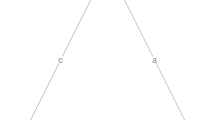Abstract
The article, “Issues and Recommendations Regarding Use of the Beck Depression Inventory” (Kendall, Hollon, Beck, Hammen, & Ingram, 1987), has had a major impact on depression research. A majority of studies using only the BDI in nonclinical samples now refer to the construct measured as “dysphoria” rather than “depression.” This word change, however, is not always accompanied by other changes in research design and interpretation that would seem warranted by the concerns that initially prompted the “dysphoria” recommendation, such as the nonspecificity of high BDI scores to major depression. Researchers typically continue to derive hypotheses from depression theory, use only the BDI to measure “dysphoria” rather than purer markers of negative affectivity, cite as a limitation of their findings the danger of assuming continuity between subclinical and clinical depression, and sometimes lapse into “depression” terminology. Alternative suggestions are made for considering how the particular goals of a study might lead to various ways of handling the continuity issue.
Similar content being viewed by others
References
American Psychiatric Association. (1987).Diagnostic and statistical manual of mental disorders. (Rev. 3rd ed.). Washington, DC: Author.
Barnett, P. A., & Gotlib, I. H. (1988). Psychosocial functioning and depression: Distinguishing among antecedents, concomitants, and consequences.Psychological Bulletin, 104 97–126.
Beck, A. T. (1967).Depression. Philadelphia: University of Pennsylvania Press.
Beck, A. T. (1971). Cognition, affect, and psychopathology,Archives of General Psychiatry, 24 495–500.
Beck, A. T., Rush, A. J., Shaw, B. F., & Emery, G. (1979).Cognitive therapy of depression. New York: Guilford Press.
Carson, R. C. (1991). Dilemmas in the pathway of the DSM-IV.Journal of Abnormal Psychology, 100 302–307.
Clark, L. A., & Watson, D. (1991). Tripartite model of anxiety and depression: Psychometric evidence and taxonomic implications.Journal of Abnormal Psychology, 100 316–336.
Coyne, J. C., & Downey, G. (1991). Social factors and psychopathology: Stress, social support, and coping processes.Annual Review of Psychology, 42 401–425.
Deardorff, W. W., & Funabiki, D. (1985). A diagnostic caution in screening for depressed college students.Cognitive Therapy and Research, 9 277–284.
Dobson, K. S. (1985). The relationship between anxiety and depression.Clinical Psychology Review, 5 307–324.
Eysenck, H. J. (1990). Biological dimensions of personality. In. L. A. Peruin (Ed.),Handbook of personality: Theory and research (pp. 244–276). New York: Guildford Press.
Flett, G. L., & Hewitt, P. L. (1990). Clinical depression and attributional complexity.British Journal of Clinical Psychology, 29 339–340.
Flett, G. L., Pliner, P., & Blankstein, K. R. (1989). Depression and components of attributional complexity.Journal of Personality and Social Psychology, 56 757–764.
Frank, J. D. (1973).Persuasion and healing. Baltimore, MD: Johns Hopkins University Press.
Garber, J., & Hollon, S. D. (1991). What can specificity designs say about causality in psychopathology research?Psychological Bulletin, 110 129–136.
Gotlib, I. H. (1984). Depression and general psychopathology in university students.Journal of Abnormal Psychology, 93 19–30.
Haaga, D. A. F., Dyck, M. J., & Ernst, D. (1991). Empirical status of cognitive theory of depression.Psychological Bulletin, 110 215–236.
Ingram, R. E. (1989). Affective confounds in social-cognitive research.Journal of Personality and Social Psychology, 57 715–722.
Ingram, R. E. (1990). Self-focused attention in clinical disorders: Review and a conceptual model.Psychological Bulletin, 107 156–176.
Ingram, R. E. (1991). Tilting at windmills: A response to Pyszczynski, Greenberg, Hamilton, and Nix.Psychological Bulletin, 110 544–550.
Ingram, R. E., & Kendall, P. C. (1987). The cognitive side of anxiety.Cognitive Therapy and Research, 11 523–536.
Jorgensen, R. S., & Richards, C. S. (1989). Negative affect and the reporting of physical symptoms among college students.Journal of Counseling Psychology, 36 501–504.
Kendall, P. C., Hollon, S. D., Beck, A. T., Hammen, C. L., & Ingram, R. E. (1987). Issues and recommendations regarding use of the Beck Depression Inventory.Cognitive Therapy and Research, 11 289–299.
Kennedy, R. E., & Craighead, W. E. (1988). Differential effects of depression and anxiety on recall of feedback in a learning task.Behavior Therapy, 19 437–454.
Klein, D. N. (1990). Symptom criteria and family history in major depression.American Journal of Psychiatry, 147 850–854.
Lehmann, H. J. (1959). Psychiatric concepts of depression: Nomenclature and classification.Canadian Psychiatric Association Journal Supplement, 4 S1-S12.
Lewinsohn, P. M., Hoberman, H. M., & Rosenbaum, M. (1988). A prospective study of risk factors for unipolar depression.Journal of Abnormal Psychology, 97 251–264.
Leydesdorff, L., & Amsterdamska, O. (1990). Dimensions of citation analysis.Science, Technology, & Human Values, 15 305–335.
Ruehlman, L. S., West, S. G., & Pasahow, R. J. (1985). Depression and evaluative schemata.Journal of Personality, 53 46–92.
Shadish, W. R., Jr. (1989). The perception and evaluation of quality in science. In B. Gholson, W. R Shadish, Jr., R. A. Neimeyer, & A. C. Houts (Eds.),Psychology of science: Contributions to metascience (pp. 383–426). Cambridge, England: Cambridge University Press.
Silverstein, S. M., Raulin, M. L., Pristach, E. A., & Pomerantz, J. R. (1992). Perceptual organization and schizotypy.Journal of Abnormal Psychology, 101 265–270.
Taylor, J. A. (1953). A personality scale of manifest anxiety.Journal of Abnormal and Social Psychology, 48 285–290.
Watson, D., & Clark, L. A. (1984). Negative affectivity: The disposition to experience aversive emotional states.Psychological Bulletin, 96 465–490.
Watson, D., Clark, L. A., & Tellegen, A. (1988). Development and validation of brief measures of Positive and Negative Affect: The PANAS scales.Journal of Personality and Social Psychology, 54 1063–1070.
Author information
Authors and Affiliations
Additional information
We are grateful to Tony Ahrens, Diane Arnkoff, and anonymous reviewers for feedback on earlier drafts.
Rights and permissions
About this article
Cite this article
Haaga, D.A.F., Solomon, A. Impact of Kendall, Hollon, Beck, Hammen, and Ingram (1987) on treatment of the continuity issue in “depression” research. Cogn Ther Res 17, 313–324 (1993). https://doi.org/10.1007/BF01177657
Issue Date:
DOI: https://doi.org/10.1007/BF01177657




